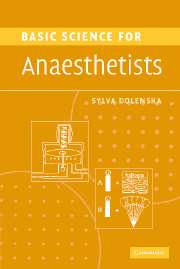Book contents
- Frontmatter
- Contents
- List of abbreviations and symbols
- List of figure captions
- Forewords
- Preface
- Preface to the second edition
- Part 1 Physics, mathematics, statistics, anaesthetic apparatus
- 1 Gas compression, relationship of volume, pressure and temperature
- 2 Real gas compression
- 3 Flow and resistance
- 4 Heat, vaporization and humidification
- 5 Simple mechanics 1: mass, force, pressure
- 6 Simple mechanics 2: work and power
- 7 Mathematical concepts
- 8 Exponentials 1: the curves
- 9 Exponentials 2: properties of exponential decay curve
- 10 Descriptive statistics
- 11 Presentation of data
- 12 Receiver operating characteristic curve
- 13 Gas supply and pressure
- 14 The circle system
- 15 The Mapleson A (Magill) breathing system
- 16 T-pieces
- 17 Lung filling with automatic lung ventilators
- Part 2 Clinical measurement
- Part 3a Physiology: the cardiovascular system
- Part 3b Physiology: the respiratory system
- Part 4 Pharmacology
- Further Reading
- Index
12 - Receiver operating characteristic curve
from Part 1 - Physics, mathematics, statistics, anaesthetic apparatus
Published online by Cambridge University Press: 13 August 2009
- Frontmatter
- Contents
- List of abbreviations and symbols
- List of figure captions
- Forewords
- Preface
- Preface to the second edition
- Part 1 Physics, mathematics, statistics, anaesthetic apparatus
- 1 Gas compression, relationship of volume, pressure and temperature
- 2 Real gas compression
- 3 Flow and resistance
- 4 Heat, vaporization and humidification
- 5 Simple mechanics 1: mass, force, pressure
- 6 Simple mechanics 2: work and power
- 7 Mathematical concepts
- 8 Exponentials 1: the curves
- 9 Exponentials 2: properties of exponential decay curve
- 10 Descriptive statistics
- 11 Presentation of data
- 12 Receiver operating characteristic curve
- 13 Gas supply and pressure
- 14 The circle system
- 15 The Mapleson A (Magill) breathing system
- 16 T-pieces
- 17 Lung filling with automatic lung ventilators
- Part 2 Clinical measurement
- Part 3a Physiology: the cardiovascular system
- Part 3b Physiology: the respiratory system
- Part 4 Pharmacology
- Further Reading
- Index
Summary
Sensitivity (detection of true positives) and specificity (detection of true negatives) of a test are important properties. In an ideal case each should be equal to 100% or the value of 1.0: all true positives should be identified by a test and all true negatives rejected, or fall below a cut-off value. In practice, this is rarely the case. A trade-off usually has to be sought between a good enough sensitivity and an acceptable specificity.
The name ‘receiver operating characteristic’ (ROC) curves was conceived during the Second World War to name the ability of radar operators to discriminate between friend or enemy blips on the screen, whilst also discounting the background noise (false positives). When tested, correct or false answers could be plotted and the result was the ROC curve. This was later taken up by the medical profession to describe the accuracy of laboratory tests.
To visualize how false positives and false negatives are related to the true values and to each other, consider Figure 42. It shows the distribution of fasting blood sugar in the normal (non-diabetic) population and in the diabetic population. Note that the distribution curve for diabetics is skewed to the right. Some overlap exists between the two populations, as not all diabetics will always have a raised fasting blood sugar, whilst a raised fasting blood sugar may on occasions be seen in a non-diabetic person.
- Type
- Chapter
- Information
- Basic Science for Anaesthetists , pp. 48 - 51Publisher: Cambridge University PressPrint publication year: 2006



